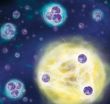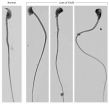(Press-News.org) LOS ANGELES (May 13, 2014) – When professional surfer Richie Lovett began experiencing hip pain at 31, he attributed it to his athletic lifestyle. But after months of discomfort and preliminary tests, the Australian native learned the pain was caused by a cancerous tumor in his femur or thigh bone.
"As a professional athlete, I was blindsided by the news that I had cancer," said Lovett. "I realized very quickly that cancer would have a profound effect on my life. I knew I needed an experienced oncologist to tackle this disease, so I began an international search to find the very best options and care."
The search led him from Australia to the Cedars-Sinai Samuel Oschin Comprehensive Cancer Institute and the care of surgical oncologist Earl Warren Brien, MD.
Brien, director of Musculoskeletal Tumor Service at the Orthopaedic Oncology Program in the Cedars-Sinai Orthopaedic Center and a lifelong surfer himself, is an expert in treating bone cancer and has pioneered many of the most groundbreaking surgical procedures in orthopedic oncology, one of which would benefit Lovett.
Brien diagnosed Lovett with a tumor called clear cell chondrosarcoma, an uncommon form of bone cancer that rarely responds to chemotherapy or radiation. Instead of therapeutic treatments, Lovett would undergo a state-of-the-art surgery to give him the best chance at surfing again.
The surgical technique, described recently in the journal Orthopedics, required Brien to remove Lovett's tumor and damaged bone in its entirety, replace it with a prosthetic and then reconnect his hip and surrounding muscle to the prosthetic implant. This innovative approach provides the greatest range of movement possible.
With standard procedures, healing can be slow and patients often need multiple follow-up surgical procedures. But when damaged bone is removed and replaced with a metal prosthesis, patients may get back to their daily activities more quickly and easily, Brien said.
"The surgical approach Richie received is unique due to the prosthetic," said Brien. "The prosthesis is made of a combination of cobalt-chrome and titanium and has a three-piece head that allows for more range of motion and greater stability. This technique gave Richie, and patients like him, a faster recovery, more predictable outcomes and better overall quality of life."
Eight years later, Lovett is free from the rare bone cancer and back in the water, surfing and enjoying a full life with his two young children and wife.
"I am committed to staying healthy and living a positive life," said Lovett. "I influence people wherever I can and am forever grateful to Dr. Brien for getting me back into the water."
INFORMATION:
Citation: Orthopedics. 2014 February: Proximal Femoral Reconstruction With a Constrained Acetabulum in Oncologic Patients.
COI Disclosure: Earl W. Brien, MD, is a consultant for Howmedica/Stryker.
Professional surfer back in the water after successful surgery to treat rare bone cancer
2014-05-13
ELSE PRESS RELEASES FROM THIS DATE:
Quantum trimer -- from a distance
2014-05-13
Eight years ago Rudolf Grimm's research group was the first to observe an Efimov state in an ultracold quantum gas. The Russian physicist Vitali Efimov theoretically predicted this exotic bound state of three particles in the 1970s. He forecast that three particles would form a bound state due to their quantum mechanical properties, under conditions when a two-body bound state would be absent. What is even more astounding: When the distance between the particles is increased by factor 22.7, another Efimov state appears, leading to an infinite series of these states. Until ...
Researchers identify link between colon cancer and metabolism
2014-05-13
HEIDELBERG, 13 May 2014 – More than 60 years ago Otto Warburg recognized that cancer cells differ from normal cells in the metabolic pathway they use for the oxidation of sugar. Rather than the typical series of oxidative steps that take place in the citric acid cycle, cancer cells metabolize sugar via the glycolytic pathway irrespective of whether oxygen is present or not. In The EMBO Journal, researchers in the United States report that the reason for this difference in colon cancer is changes in the Wnt signaling pathway, an essential communication pathway operating ...
Dangerous nitrogen pollution could be halved
2014-05-13
Ambitious mitigation efforts, however, could decrease the pollution by 50 percent. The analysis is the very first to quantify this.
"Nitrogen is an irreplaceable nutrient and a true life-saver as it helps agriculture to feed a growing world population – but it is unfortunately also a dangerous pollutant," says Benjamin Bodirsky, lead-author of the study. In the different forms it can take through chemical reactions, it massively contributes to respirable dust, leads to the formation of aggressive ground-level ozone, and destabilizes water ecosystems. Damages in Europe ...
Male infertility: It's all about the package
2014-05-13
Cold Spring Harbor, NY – Infertility is generally thought of as a woman's problem. In fact, more than 3 million men across America also experience it. Today, researchers from Cold Spring Harbor Laboratory (CSHL) describe a key event during sperm development that is essential for male fertility. A team led by CSHL Professor Alea Mills explains how a protein controls DNA packaging to protect a man's genetic information.
The sperm is a simple delivery vehicle for a man's genetic information. The highly specialized cell is little more than a DNA bundle powered by molecular ...
Concerns raised over EU ban on ditching unwanted fish
2014-05-13
New rules banning fishermen from throwing away unwanted fish they have caught could harm wildlife – and fail to improve fish stocks, a University of Strathclyde report has found.
The study, published in the journal Nature Communications, suggests new reforms to the European Union's Common Fisheries Policy (CFP) – ending the practice of throwing away unwanted fish caught at sea – may have unintended consequences. The new CFP took effect on 1 January 2014 and will phase out the discarding of fish between 2015 and 2019.
The aim is to improve fish stocks – but Professor ...
Researchers identify genetic marker linked to OCD
2014-05-13
A group of researchers led by Johns Hopkins scientists say they have identified a genetic marker that may be associated with the development of obsessive-compulsive disorder (OCD), whose causes and mechanisms are among the least understood among mental illnesses.
The results of the research are published online May 13 by the journal Molecular Psychiatry.
"If this finding is confirmed, it could be useful," says study leader Gerald Nestadt, M.D., M.P.H., a professor of psychiatry and behavioral sciences at the Johns Hopkins University School of Medicine and director of ...
Humans and companion animals harbor the same types of MRSA infections
2014-05-13
A shared population of methicillin-resistant Staphylococcus aureus (MRSA) bacteria circulates both in humans and companion animals, according to a study published this week in mBio®, the online open-access journal of the American Society for Microbiology.
"Our study demonstrates that humans and companion animals readily exchange and share MRSA bacteria from the same population," says senior author Mark Holmes, senior lecturer in preventive veterinary medicine at the University of Cambridge in England. MRSA naturally lives on the skin and also causes difficult-to-treat ...
E-cigarettes and mental health
2014-05-13
Researchers at University of California, San Diego School of Medicine report that people living with depression, anxiety or other mental health conditions are twice as likely to have tried e-cigarettes and three times as likely to be current users of the controversial battery-powered nicotine-delivery devices, as people without mental health disorders.
They are also more susceptible to trying e-cigarettes in the future in the belief that doing so will help them quit, the scientists said. The FDA has not approved e-cigarettes as a smoking cessation aid.
The study will ...
Novel target found for chemotherapy-resistant leukemia cells
2014-05-13
Researchers at Children's Hospital Los Angeles have discovered that by targeting a particular receptor, chemotherapy-resistant cancer cells can be killed in an acute form of childhood leukemia, offering the potential for a future treatment for patients who would otherwise experience relapse of their disease.
Nora Heisterkamp, PhD, and colleagues at The Saban Research Institute of Children's Hospital Los Angeles have discovered that by targeting the B-cell activating receptor (BAFF-R), chemotherapy-resistant precursor B acute lymphoblastic leukemia cells (pre-B ALL) can ...
Older, sicker men with early-stage prostate cancer do not benefit from aggressive treatment
2014-05-13
Treating older men with early-stage prostate cancer who also have other serious underlying health problems with aggressive therapies such as surgery or radiation therapy does not help them live longer and, in fact, can be detrimental, according to a study by UCLA researchers.
The study followed the cases of more than 140,500 men aged 66 and older diagnosed with early-stage prostate cancer between 1991 and 2007 from the Surveillance, Epidemiology and End Results (SEER) Medicare database. Men who also suffered from multiple major medical conditions such as a history of ...






